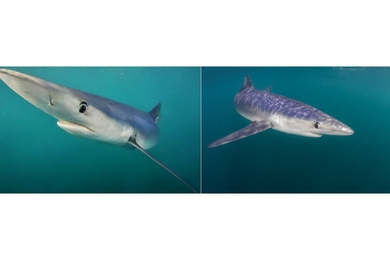 Under Development
Under Development
In the Northeastern United States, the Gulf of Maine represents one of the most biologically diverse marine ecosystems on the planet — home to whales, sharks, jellyfish, herring, plankton, and hundreds of other species. But even as this ecosystem supports rich biodiversity, it is undergoing rapid environmental change. The Gulf of Maine is warming faster than 99 percent of the world’s oceans, with consequences that are still unfolding.
A new research initiative developing at MIT Sea Grant, called LOBSTgER — short for Learning Oceanic Bioecological Systems Through Generative Representations — brings together artificial intelligence and underwater photography to document the ocean life left vulnerable to these changes and share them with the public in new visual ways. Co-led by underwater photographer and visiting artist at MIT Sea Grant Keith Ellenbogen and MIT mechanical engineering PhD student Andreas Mentzelopoulos, the project explores how generative AI can expand scientific storytelling by building on field-based photographic data.
Just as the 19th-century camera transformed our ability to document and reveal the natural world — capturing life with unprecedented detail and bringing distant or hidden environments into view — generative AI marks a new frontier in visual storytelling. Like early photography, AI opens a creative and conceptual space, challenging how we define authenticity and how we communicate scientific and artistic perspectives.
In the LOBSTgER project, generative models are trained exclusively on a curated library of Ellenbogen’s original underwater photographs — each image crafted with artistic intent, technical precision, accurate species identification, and clear geographic context. By building a high-quality dataset grounded in real-world observations, the project ensures that the resulting imagery maintains both visual integrity and ecological relevance. In addition, LOBSTgER’s models are built using custom code developed by Mentzelopoulos to protect the process and outputs from any potential biases from external data or models. LOBSTgER’s generative AI builds upon real photography, expanding the researchers’ visual vocabulary to deepen the public’s connection to the natural world.
Here’s How It Works:
1. Refer a Friend: Share the name and contact details of anyone who might benefit from our innovative web solutions.
2. They Sign a Deal: When your referral becomes a client and completes a $5,000+ contract with us, you get rewarded.
3. Get Paid: Receive $1,000 in cash as a thank you for your referral after final payment has been received from the referred client!
It’s that simple. Help your friends get the best in web design and development, and earn big while doing it. Start referring today and watch your rewards grow!
*Subject to IRS income tax rules and regulations
©2013-2025 | All rights reserved.